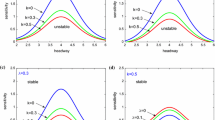Abstract
The integral part of the optimal velocity car-following models is the optimal velocity function (OVF), which can be derived from measured velocity-spacing data. This paper discusses several characteristics of the OVF and presents regression analysis on two classical datasets, the Lincoln and Holland tunnels, with different possible OVFs. The numerical simulation of the formation of traffic congestion is conducted with three different heuristic OVFs, demonstrating that these functions give results similar to those of the famous Bando OVF (Bando et al., 1995). Also an alternative method is present for determining the sensitivity and model parameters based on a single car driving to a fixed barrier.
Similar content being viewed by others
References
Bando, M., Hasabe, K., Nakayama, A., Shibata, A., Sugiyama, Y., 1995. Dynamical model of traffic congestion and numerical simulation. Physical Review E, 51(2):1035–1042. [doi:10.1103/PhysRevE.51.1035]
Batista, M., 2000. Numerical Simulation of Traffic Congestion. International Conference on Traffic Science. Portorož, Slovenia, p.361–367.
Brackstone, M., McDonald, M., 2000. Car following: a historical review. Transportation Research Part F, 2(4):181–196. [doi:10.1016/S1369-8478(00)00005-X]
Daganzo, C.F., 2003. Fundamentals of Transportation and Traffic Operations. Science Ltd., USA.
Davis, L.C., 2003. Modifications of the optimal velocity traffic model to include delay due to driver reaction time. Physica A: Statistical Mechanics and its Applications, 319(1):557–567. [doi:10.1016/S0378-4371(02)01457-7]
Del Castillo, J.M., Benitez, F.G., 1995a. On the functional form of the speed-density relationship—I: general theory. Transportation Research Part B: Methodological, 29(5): 373–389. [doi:10.1016/0191-2615(95)00008-2]
Del Castillo, J.M., Benitez, F.G., 1995b. On the functional form of the speed-density relationship—II: empirical investigation. Transportation Research Part B: Methodological, 29(5):391–406. [doi:10.1016/0191-2615(95)00009-3]
Edie, L.C., 1961. Car-following and steadystate theory for noncongested traffic. Operations Research, 9(1):66–76. [doi:10.1287/opre.9.1.66]
Gasser, S.G., Werner, B., 2004. Bifurcation analysis of a class of ‘car following’ traffic models. Physica D: Nonlinear Phenomena, 197(3–4): 222–241. [doi:10.1016/j.physd.2004.07.008]
Helbing, D., Tilch, B., 1998. Generalized force model of traffic dynamics. Physical Review E, 58(1):133–138. [doi:10. 1103/PhysRevE.58.133]
Holland, E.N., 1998. A generalized stability criterion for motorway traffic. Transportation Research Part B: Methodological, 32(1):141–154. [doi:10.1103/PhysRevE.58. 133]
Jiang, R., Wu, Q., Zhu, Z., 2001. Full velocity difference model for car-following theory. Physical Review E, 64(1): 017101. [doi:10.1103/PhysRevE.64.017101]
Kerner, B.S., Konhauser, P., 1993. Cluster effect in initially homogeneous traffic flow. Physical Review E, 48(4):R2335–R2338. [doi:10.1103/PhysRevE.48.R2335]
Kesting, A., Treiber, M., 2009. Calibration of Car-following Models Using Floating Car Data. In: Traffic and Granular Flow’07. Springer, Berlin, Germany. [doi:10.1007/978-3-540-77074-9_10]
Li, L., Shi, P., 2006. Numerical analysis on car-following traffic flow models with Delay Time. Journal of Zhejiang University-SCIENCE A, 7(2):204–209. [doi:10.1631/2009.2006.A0204]
May, A.D., 1990. Traffic Flow Fundamentals. Prentice-Hall, New York, USA.
Nakanishi, K., Itoh, K., Igarashi, Y., Bando, M., 1997. Solvable optimal velocity models and asymptotic trajectory. Physical Review E, 55(6):6519–6532. [doi:10.1103/PhysRevE.55.6519]
Newell, G.F., 1961. Nonlinear effects in the dynamics of car following. Operations Research, 9(2):209–229. [doi:10.1287/opre.9.2.209]
Orosz, G., Wilson, R.E., Krauskopf, B., 2004. Global bifurcation investigation of an optimal velocity traffic model with driver reaction time. Physical Review E, 70(2): 026207. [doi:10.1103/PhysRevE.70.026207]
Orosz, G., Krauskopf, B., Wilson, R.E., 2005. Bifurcations and multiple traffic jams in a car-following model with reaction-time delay. Physica D: Nonlinear Phenomena, 211(3–4):277–293. [doi:10.1016/j.physd.2005.09.004]
Rajamani, R., 2006. Vehicle Dynamics and Control. Springer, New York, USA.
Rothery, R.W., 1997. Car Following Models. In: Monograph on Traffic Flow Theory. Available from http://www.tfhrc.gov/its/tft/tft.htm.
Tadaki, S., Kikuchi, M., Sugiyama, Y., Yukawa, S., 1999. Noise induced congested traffic flow in coupled map optimal velocity model. Journal of Physical Society of Japan, 68(9):3110–3114. [doi:10.1143/JPSJ.68.3110]
Weng, Y., Wu, T., 2002. Car-following models of vehicular traffic. Journal of Zhejiang University-SCIENCE A, 3(4):412–417. [doi:10.1631/2009.2002.0412]
Wilson, R.E., 2008. Mechanisms for spatio-temporal pattern formation in highway traffc models. Philosophical Transactions of the Royal Society A: Mathematical Physical and Engineering Sciences, 366:2017–2032. [doi:10.1098/rsta.2008.0018]
Zhao, X., Gao, Z., 2005. A new car-following model: full velocity and acceleration difference model. The European Physical Journal B, 47(1):145–150. [doi:10.1140/epjb/e2005-00304-3]
Zhu, W., Liu, Y., 2008. A total generalized optimal velocity model and its numerical tests. Journal of Shanghai Jiaotong University (Science), 13(2):166–170. [doi:10.1007/s12204-008-0166-9]
Author information
Authors and Affiliations
Corresponding author
Rights and permissions
About this article
Cite this article
Batista, M., Twrdy, E. Optimal velocity functions for car-following models. J. Zhejiang Univ. Sci. A 11, 520–529 (2010). https://doi.org/10.1631/jzus.A0900370
Received:
Accepted:
Published:
Issue Date:
DOI: https://doi.org/10.1631/jzus.A0900370




